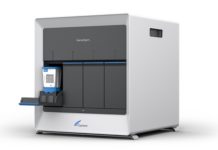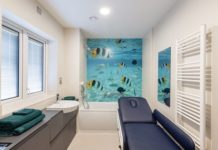Intuitive surgical standardizes on xilinx fpga-based design blocks to Innovate 3d vision and precise control for robotic-assisted surgery.
Saving lives, reducing recovery times it’s all about patient value. This is the proud mantra of one of the most interesting companies in the medical electronics industry: Intuitive Surgical. Already in use at 1,500+ sites worldwide, the company’s da Vinci® Surgical Systems maximize value for many patients by increasing the applicability of minimally invasive surgery (MIS). Intuitive Surgical has worked with Xilinx since 2003 to speed the delivery of new, more advanced da Vinci capabilities to operating rooms.
Xilinx FPGAs have contributed to multiple generations of the system, and Intuitive Surgical engineers continue to embrace the programmable devices for exceptional bandwidth, embedded processing speed, and flexibility.
MARKET AND DESIGN CHALLENGES
Minimally invasive surgery means significantly less trauma and much faster recovery for patients than conventional open surgery. However, MIS procedures based on conventional laparoscopy have been very limited in their applications. Intuitive Surgical was founded to change that with a revolutionary technology platform. By combining the benefits of MIS with the precision, dexterity,and control of robotics and the accuracy of breakthrough 3D visualization, the da Vinci System has brought MIS to a broader range of specialties. Starting with cardiac and general surgery, the new platform has enabled methodologies for urology, pediatric, gynecology, colorectal, and head and neck surgeries.
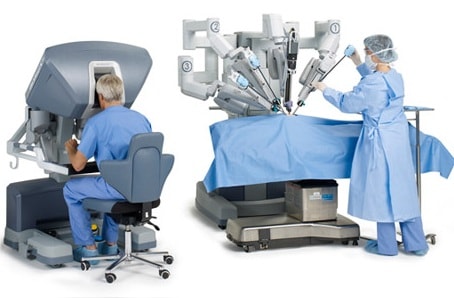
Intuitive Surgical is all about giving each patient the best possible surgery experience, including rapid recovery our focus is always on the overall value we deliver to the patients,” explained Sal Brogna, Senior Vice President of Engineering at Intuitive Surgical.
Originally inspired by technology advances stemming from research at the Defense Advanced Research Projects Agency (DARPA), Intuitive Surgical’s robotic MIS system required overcoming numerous engineering challenges. One area, video processing, has become increasingly important as the da Vinci models have evolved from 3D standard-definition stereo vision to today’s dual-console, multi-window 3D high-definition (HD) system.
“When we were updating the original video processing subsystem, we wanted to introduce multiwindowed video sources for the surgeon, so they could monitor vital patient data during surgeries,” said David Powell, Principal Design Engineer for Intuitive Surgical video processing solutions.
An increase in video processing bandwidth would allow us to display data from auxiliary video sources, along with the view of the operating field. The doctor would have instant feedback from an ultrasound or heart-lung machine without taking their eyes off of the procedure in progress.
Besides the technical challenges of giving surgeons an expanded, immersive view that could shorten procedures and improve outcomes, the video solution had to align with the other overall system objectives. These included stringent safety and reliability requirements.
SOLUTION
The investigation into display enhancements led to an evaluation and eventual selection of a Xilinx Virtex® FPGA for inclusion in the video processing design for the second-generation da Vinci Surgery Systems.
We initially selected a Xilinx Virtex-2 Pro FPGA solely on the performance of the DSP elements for streaming video,” said Powell. “The embedded processor was a ‘nice-to-have’ feature — we realized we could take advantage of it to reduce the real estate for video processing, but the embedded processor wasn’t a fundamental reason for our selection of the Xilinx device. As it has turned out, Xilinx’ embedded processor architecture has led to a pretty major revolution for us in terms of our subsequent platform designs throughout the entire system.
Introducing Replicable, Modular Designs
The first experience with Xilinx FPGAs led to the adoption of the devices in other system modules. “As we started using the Xilinx device, we discovered it to be quite a nice design platform so nice, in fact, that follow-on platforms have evolved to employ dozens of Xilinx FPGAs in all of the main system components,” said Powell.
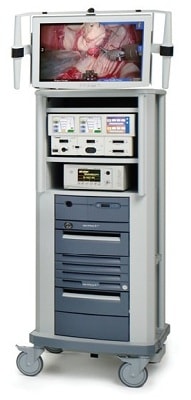 The embedded hard processor, MicroBlaze™ soft processor, and the functional breadth of the programmable Xilinx families have allowed Intuitive Surgical to greatly increase design re-use within and across design teams. “Using a cookie-cutter approach, we have been able to standardize many functions and build these blocks into new designs very quickly,” said Powell. “Our first board to employ a Xilinx FPGA was up and running in two hours. After that, we found we could get a board up and running in just minutes these kind of results
The embedded hard processor, MicroBlaze™ soft processor, and the functional breadth of the programmable Xilinx families have allowed Intuitive Surgical to greatly increase design re-use within and across design teams. “Using a cookie-cutter approach, we have been able to standardize many functions and build these blocks into new designs very quickly,” said Powell. “Our first board to employ a Xilinx FPGA was up and running in two hours. After that, we found we could get a board up and running in just minutes these kind of results
are almost unheard of.”
Today, Intuitive Surgical has embraced an open, scalable design flow that takes advantage of a reusable processor design. Xilinx-based building blocks shorten design time and cost-effectively leverage the expertise of the in-house architectural experts. “From a business standpoint, we can do more with a few key resources to work faster and smarter,” explained Brogna. “The reusable blocks and scalable design flow now goes beyond video to benefit our general communications and servo control designs. Re-use is especially important in medical devices — designs can be hardened by multiple teams and applications. We gain a high degree of safety and ultimately deliver a more reliable product to the operating room.”
The Ripple Effect From Modules to Interconnects to Serviceability
Prior to using Xilinx FPGAs, da Vinci system interconnections were varied and complex. Four large “garden hose” cables had high failure rates due to constant manipulation during surgical set-up in the operating rooms. More significantly, system components had to be manufactured and repaired as an integrated unit. Many repairs required sending the entire system out for service.
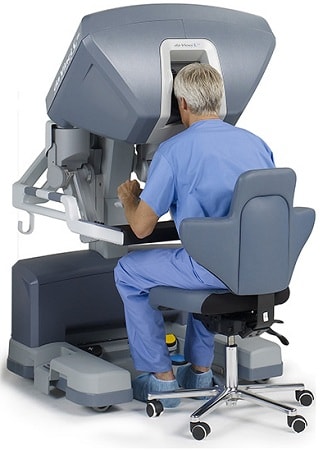
Today, a single fiber cable design provides standardized connections between all system modules. The Xilinx hard processor blocks and high-speed DSP slices provide system-on-a-chip capabilities that support eight channels of full 1080i HD video (20Gbps) across the simplified interconnect.
The modular design methodology has also revolutionized manufacturability, testability, reliability, and serviceability. Brogna stated, “A flexible, customizable design block made us think about everything in new ways we now focus on modules and cards. Even manufacturing doesn’t talk about shipping systems they talk about cards. This has made us incredibly agile and effective in terms of producing and testing products and servicing systems in the field.”
The power of programmability also means simplified updates. Instead of replacing modules or subsystems, a new capability can often be introduced or enhanced with an in-field firmware upgrade.Service teams can also quickly query for consistency across all the processors in the system, for improved process control and ensuring that systems are optimally configured for surgery.
Collaborating With Xilinx to Maximize Results
“Through the years, we’ve seen how Xilinx has pioneered FPGAs and embedded processing,” said Powell. “Today, we can fit so much in each FPGA we can turn a board into a chip, pretty much.And power continues to come down, which is essential for some of our modules.
But at least 50% of the reason we stay with Xilinx is the working relationships we have. Sales,engineering, and executive teams at Xilinx really help us get the best results with Xilinx solutions.We know Xilinx devices backwards and forwards now, and this really helps us make a difference in many lives.
It always comes back to the patients we hear from people every day who tell us how a new procedure changed or saved their life. That’s what motivates us to deliver the best technology.
After the incorporation of the first Virtex-2 FPGA, Intuitive Surgical has taken advantage of follow on Virtex and Spartan FPGAs. The product family roadmap, associated development tools and methodologies, and modularized da Vinci design continue to drive down development time.
FAR-REACHING RESULTS
With the standardization on Xilinx FPGAbased design blocks that span processing, memory, flash, and more — Intuitive Surgical has also been able to evolve to a more distributed architecture for da Vinci Systems.The modular, flexible design has in turn fostered innovation with a scalable design flow, and made it more efficient for Intuitive Surgical to bring break-through functional advancements to market.
“The distributed architecture helped us introduce support for dual consoles,” said Brogna. “Now two surgeons can collaborate in a robotic MIS procedure, or set up a trainer-student configuration. The modular, Xilinx-enabled designs contribute to this capability — which marks a major milestone in our product line.”
By helping Intuitive Surgical drive up video and processing bandwidth, Xilinx devices ultimately benefit da Vinci customers and the patients they serve. For many hospitals, this means:
- More procedures performed per day, for improved OR usage/cost basis
- Reduced procedure costs, which contribute to a hospital’s bottom line, especially with the
increase of fixed-payment plans - Fewer patient complications for improved overall satisfaction and limited liability risks
Doctors benefit from the enhanced visualization and system ergonomics, reporting less eye strain and improved dexterity and control especially for procedures that require very high magnification. For the first time in their careers, many surgeons can now sit down during procedures greatly reducing fatigue.
One doctor shared that he can now do seven or eight reverse vasectomy procedures per day, instead of the two-per-day rate prior to da Vinci,” explained Chris Simmonds, Senior Director, Marketing Services at Intuitive Surgical.
“With our patented visualization, including 360-degree motion, tremor filtration, and translation of large hand movements to tiny tool movements, we are helping surgeons improve results, increase productivity, and lower costs. The da Vinci solution is also extending careers by allowing doctors in the latter phases of their career to better handle the physical demands of their profession.”
For patients and their families, increased precision means better outcomes. Faster
procedures mean less anasthesia and therefore shorter recovery times and less time in the hospital makes all patients happier.
Shorter procedures also mean that surgeons including the most experienced specialis are more accessible to more patients.
Everything at Intuitive Surgical comes back to the patient and providing them with the best possible experiences. By partnering with Xilinx, Intuitive Surgical enjoys working relationships that give them access to information about the latest advancements in silicon device technologies. “We need to keep driving ease of use and simplicity for surgical teams,” summarized Brogna. “We push our engineers we make problems harder for them so that we can make life easier for our customers.
Xilinx gets that, and they bring us ideas and solutions that contribute to our mission.”
About Xilinx
Xilinx is the leading provider of All Programmable FPGAs, SoCs, MPSoCs, RFSoCs, and 3D ICs. Xilinx uniquely enables applications that are both software defined and hardware optimized – powering industry advancements in Cloud Computing, Video/Vision, Industrial IoT, and 5G Wireless. For more information, visit www.xilinx.com.










